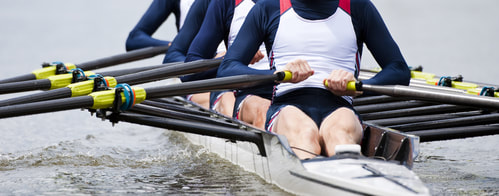The rowboat has advanced tremendously since its inception. The transition from transportation and warfare to sports required innovation in materials and design. When your goal is speed, you need the best aerodynamic architecture possible.
Row Boats Become High-Tech
Competitive rowboats were originally constructed from birch or cedar wood. This changed in the 1980's when epoxy and fiberglass became standard. The oars, which are used to propel the crew and stabilize the boat across the water, were also originally crafted from wood. Today, the oars are made of lightweight carbon fiber. The surface blade of the oar has been adapted to suit the need for ease and speed. In 1991, the “cleaver” oar made its debut, further enhancing performance.
While sliding seats that move back and forth seem standard and obvious today, they were not always so. Prior to 1857, the seats were stationary. Rowers had to grease the seat and wear leather to ease the forward/backward motion.
Anyone who's watched crews practice notices that an important element is the precision timing of the rowing. The cadence of the crew leader became more sophisticated and reliable with the introduction of the Cox Box in 1979. This device contains a timer watch, speaker and stroke rate tracker in one unit, greatly improving training.
Taking advantage of big data and digital technologies, rowing has become less “feel and intuition” and more scientific. The oars have a special sensor on the blade that provides instant feedback about the pressure being applied on each stroke. Now the crew leader, instead of relying on visual inspection, knows exactly what is going on with each crew member.
While sliding seats that move back and forth seem standard and obvious today, they were not always so. Prior to 1857, the seats were stationary. Rowers had to grease the seat and wear leather to ease the forward/backward motion.
Anyone who's watched crews practice notices that an important element is the precision timing of the rowing. The cadence of the crew leader became more sophisticated and reliable with the introduction of the Cox Box in 1979. This device contains a timer watch, speaker and stroke rate tracker in one unit, greatly improving training.
Taking advantage of big data and digital technologies, rowing has become less “feel and intuition” and more scientific. The oars have a special sensor on the blade that provides instant feedback about the pressure being applied on each stroke. Now the crew leader, instead of relying on visual inspection, knows exactly what is going on with each crew member.
Rowing Becomes an Established Olympic Sport
In the early 1900's, competitive rowing took its place alongside other time-honored Olympic sports. As was noted in The Evolution of Competitive Rowing (Part I), the United States enjoyed early victories over other nations in the sport of rowing. In fact, for 36 years, beginning in 1920, the US men’s team repeatedly won the gold medal, leaving competing countries in the dust.
The Soviet Union took the honor from the Americans and dominated the Olympic rowing competition until the mid-1980's. The Soviets were displaced by East Germany. Of course, today Germany is united and the USSR no longer exists. But, rowing in the Olympics continues to draw the most elite crews and individuals.
The Soviet Union took the honor from the Americans and dominated the Olympic rowing competition until the mid-1980's. The Soviets were displaced by East Germany. Of course, today Germany is united and the USSR no longer exists. But, rowing in the Olympics continues to draw the most elite crews and individuals.
Women Rowers Finally Receive Recognition
Women were not allowed to compete until 1976's Olympics in Montreal. However, before this, women were already competing in rowing events. The first rowing event for women took place in 1927. The “Women’s Boat Race” was an exhibition between Cambridge and Oxford University. The women succeeded in earning the recognition they deserved and the event was renamed a race.
In 1957, the European Rowing Championships opened to women competitors. The most competitive female rowers came from Eastern Europe; Romania, Bulgaria, and Russia. Recently, the US established the NCAA Rowing Championships for women, strengthening the position of American women crews in the international scene.
In 1957, the European Rowing Championships opened to women competitors. The most competitive female rowers came from Eastern Europe; Romania, Bulgaria, and Russia. Recently, the US established the NCAA Rowing Championships for women, strengthening the position of American women crews in the international scene.



